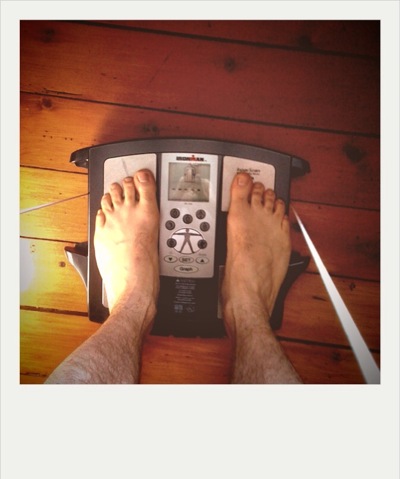Getting to Know Me – Body Monitoring with a Tanita Scale

During each visit to my doctor’s office the nurse who escorts me to the exam room swings me by the practice’s ancient Health-O-Meter scale and takes a quick check of my weight. She then looks at a BMI (Body Mass Index) chart, and makes a note of whether or not I’m at risk for a myriad weight-based diseases. According to the BMI number, I’m pushing obese but if you look at me you’ll see pretty quickly the problem with the use of BMI as a benchmark for fitness–the calculation assumes a sedentary subject and I’m anything but sedentary. As I ramped up my workouts this winter at the gym my weight increased as I put on muscle. But the BMI number crept up even though I was getting healthier.
A much more accurate measurement would be that of total body fat, which looks not at total weight but the total amount of a body that’s fat, giving a much better picture of overall health. Previously it was difficult to get an accurate reading, but electronic devices such as body fat measuring scales from companies like Tanita have simplified the process. These devices use a low-level electrical current passed through the skin to measure the resistance to the current, and based on the delay in the signal can determine how much of one’s mass is fat. Fat and muscle have different densities so the signal travels differently though each–you can think of it like sonar for your body.
Their newer scales take this a step farther with “segmental body composition,” which indicates not only the total percentage of body fat but the amount in each limb in the body’s core as well. I’ve spent a month with the new scale, and it’s changed how I look at me, from the inside.
The Tanita BC-558 Segmental Body Composition Scale has been occupying a good space in my bedroom–and in my workout program. The scale is simple to use, a moment or two of setup (it needs to know your height, age and weight) and you’re ready to go. Aside from a set of foot pads there are hand-held grips that connect to the scale with a retractable cord. These allow the scale to shoot in pulses from different places to calculate your entire body composition.
The Tanita scale provides not only total body fat percentage but the fat percent for individual arms and legs, as well as the trunk, and also provides muscle weight for each segment. It can further calculate things such as bone density (I’ve got about seven pounds of bones in me) and visceral fat, which is the dangerous fat that hangs out around your organs.
Finally, the BC-558 can use this data to determine a baseline metabolic rate–the number of calories your body needs just to function on a daily basis. This is incredibly handy for the calorie-watching cyclist trying to shed some pounds.
The BC-558 tracks changes and displays them on the large LCD display that comprises much of the top of the unit. Depicted as a graph, it’s easy to see fluctuations in body composition, although it’s best to write down measurements as well, if you’re really serious about tracking your goals. (A newer unit the BC-1000 will feature ANT+ wireless communications, allowing the data to be sent to a Garmin FR-60 fitness watch.)
For the last few months I’ve been tracking my numbers as I work out at the gym and ramp up my spring cycling. At first I was obsessively tracking changes, hitting the scale every day to see what numbers had tweaked. It’s interesting, for example, to watch one’s arm muscle mass number drop just following a hard weightlifting session and then rise above the previous number after recovery.
More recently though I’ve been stepping on the Tanita every week or so and the numbers are interesting, though I’m not entirely sure they’re in line with other observations. For example, my first readings were on March 17, and in the nearly two months the Tanita scale says that I’ve lost weight (which I can confirm) but that I haven’t gained any muscle mass in my arms, have slightly lost some in my legs and core. That’s not in line with the fact that I’ve been lifting at least twice a week since March while increasing my miles, and that my lifting totals are up.
Still, as a long-term tool I’m sure it would be very helpful, helping me to stay on target. (A massive change in weight or mass would signal necessary changes in my routine.) But it’s not as absolute as something like a lactate threshold test or a power output number–the electrical impedance tests the scale runs are only so accurate, and the fluctuate with the levels of hydration in the body.
At $300, the scale is either a bargain or an obsessive luxury item, depending on your goals. For the racer, spending money on a power meter might be a better idea, but for the recreational cyclist turning to riding as a means of losing weight, it’s a fantastic tool.